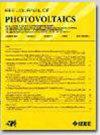Sensitivity Analysis of Eddy Current Excess Carrier Recombination Lifetime Measurements Due to Input Parameter Uncertainty
IF 2.5
3区 工程技术
Q3 ENERGY & FUELS
引用次数: 0
Abstract
For decades, excess carrier recombination lifetime measurements using an eddy current photoconductance sensor have been essential in characterizing the quality of silicon photovoltaic samples prior to metallization. Key metrics reported from the analysis of these measurements include injection-dependent excess carrier recombination lifetime, emitter saturation current density, bulk lifetime, and the implied current–voltage curve. These metrics are crucial for process control, optimization, and technological advancements in photovoltaic research and development, as well as production. As modern high-efficiency cell designs increasingly rely on precise determination of these metrics, it is important to quantify their uncertainty due to all factors; this study specifically examines their sensitivity to uncertainties in the sample-specific input parameters required for their reporting. Overall, results with a high level of confidence, including less than 1-fA/cm2 uncertainty in emitter saturation current density and less than 1-mV uncertainty in implied输入参数不确定性下涡流过量载流子复合寿命测量的灵敏度分析
几十年来,使用涡流光电导传感器测量多余载流子复合寿命对于表征金属化之前硅光伏样品的质量至关重要。分析这些测量结果的关键指标包括注入相关的多余载流子复合寿命、发射极饱和电流密度、体寿命和隐含的电流-电压曲线。这些指标对于光伏研发和生产的过程控制、优化和技术进步至关重要。由于现代高效电池设计越来越依赖于这些指标的精确测定,因此量化所有因素造成的不确定性非常重要;本研究特别检查了他们对报告所需的样本特定输入参数的不确定性的敏感性。总体而言,通过了解输入厚度和衬底电阻率,可以获得高置信度的结果,包括发射极饱和电流密度小于1 fa /cm2的不确定性和隐含的${V}_{\ maththrm {oc}}$小于1 mv的不确定性。
本文章由计算机程序翻译,如有差异,请以英文原文为准。
求助全文
约1分钟内获得全文
求助全文
来源期刊

IEEE Journal of Photovoltaics
ENERGY & FUELS-MATERIALS SCIENCE, MULTIDISCIPLINARY
CiteScore
7.00
自引率
10.00%
发文量
206
期刊介绍:
The IEEE Journal of Photovoltaics is a peer-reviewed, archival publication reporting original and significant research results that advance the field of photovoltaics (PV). The PV field is diverse in its science base ranging from semiconductor and PV device physics to optics and the materials sciences. The journal publishes articles that connect this science base to PV science and technology. The intent is to publish original research results that are of primary interest to the photovoltaic specialist. The scope of the IEEE J. Photovoltaics incorporates: fundamentals and new concepts of PV conversion, including those based on nanostructured materials, low-dimensional physics, multiple charge generation, up/down converters, thermophotovoltaics, hot-carrier effects, plasmonics, metamorphic materials, luminescent concentrators, and rectennas; Si-based PV, including new cell designs, crystalline and non-crystalline Si, passivation, characterization and Si crystal growth; polycrystalline, amorphous and crystalline thin-film solar cell materials, including PV structures and solar cells based on II-VI, chalcopyrite, Si and other thin film absorbers; III-V PV materials, heterostructures, multijunction devices and concentrator PV; optics for light trapping, reflection control and concentration; organic PV including polymer, hybrid and dye sensitized solar cells; space PV including cell materials and PV devices, defects and reliability, environmental effects and protective materials; PV modeling and characterization methods; and other aspects of PV, including modules, power conditioning, inverters, balance-of-systems components, monitoring, analyses and simulations, and supporting PV module standards and measurements. Tutorial and review papers on these subjects are also published and occasionally special issues are published to treat particular areas in more depth and breadth.
 求助内容:
求助内容: 应助结果提醒方式:
应助结果提醒方式:


